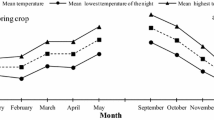Summary
The sprouts of ten cultivars, grown from 5-g tuber pieces were treated daily with either distilled water or 0.01M calcium sulphate solution. Calcium application was necessary to maintain growth of the main sprout in all the cultivars. In the absence of added calcium apical dominance was lost and lateral branches developed; those of Pentland Dell were diageotropic and produced tubers. This behaviour is known as ‘little potato’ disorder, confirming the recognized susceptibility of this cultivar to the disorder.
Zusammenfassung
Die Keime von zehn Sorten, angezogen aus Knollenstücken von je 5 g, wurden täglich entweder mit destilliertem Wasser oder mit einer Lösung von 0,01M kalziumsulfat behandelt. In allen Fällen war die Anwendung von Kalzium unentbehrlich, um das Wachstum unter den angewandten Versuchsbedingungen aufrechtzuerhalten (Abb. 1 und 3), andernfalls entwickelten sich Mangelsymptome. Die Zeit bis zur Erscheinung von Symptomen und die endgültige Länge der Hauptachse des Triebs hingen von der Dauer der Lagerungsperiode der Knollen und von der Sorte ab (Abb. 4). Kalziummangel bewirkte immer den Verlust der apikalen Dominanz, dem oftmals die Entwicklung von subapikalen Nekrosen voranging (Abb. 2 und 5). Subapikale Nekrosen traten konstant bei den Sorten Majestic, Arran Pilot, Désirée und King Edward auf sowie bei einigen Keimen von Record, Maris Peer und Pentland Crown. Es scheint, dass die letzten beiden Sorten nach längerer Lagerung weniger anfällig werden. Maris Piper, Pentland Ivory und Pentland Dell zeigten kaum Anzeichen von subapikalen Nekrosen, die Keimspitzen blieben anscheinend gesund, aber das Längenwachstum hörte auf. Die Seitentriebe von Pentland Dell und King Edward waren diageotropisch, aber nach dem Auspflanzen gewannen jene von King Edward wiederum negativen. Geotropismus und erzeugten belaubte Triebe, während die meisten Seitentriebe von Pentland Dell diageotropisch blieben und eher Knollen als Triebe mit Blättern erzeugten (Abb. 7). Diese Eigenschaft scheint mit der Anfälligkeit dieser Sorte für ‘Knöllchensucht’ im Zusammenhang zu stehen.
Résumé
Les germes de 10 cultivars, développés à partir de fragments de tubercules de 5 g, sont traités journellement soit avec de l’eau distillée, soit avec une solution de 0,01M de sulfate de calcium. Dans tous les cas, l’application de calcium est indispensable au maintien de la croissance dans les conditions expérimentales réalisées (fig. 1 et 3), sinon des symptômes d’insuffisance se manifestent. Le temps nécessaire à l’apparition des symptômes et la longueur finale de l’axe principal du germe dépendent de la longueur de la période de stockage du tubercule et du cultivar (fig. 4). La déficience de calcium produit toujours une perte de dominance apicale qui, fréquemment, précède l’apparition de nécrose sub-apicale (fig. 2 et 5). La nécrose sub-apicale apparaît invariablement chez Majestic, Arran Pilot, Désirée et King Edward, et dans quelques germes chez Record, Maris Peer et Pentland Crown. Ces deux derniers cultivars semblent devenir moins susceptibles après une conservation prolongée. Maris Piper, Pentland Ivory et Pentland Dell montrent rarement des signes de nécrose subapicale, le germe apical restant apparemment sain mais l’élongation étant stoppée. Les branches latérales chez Pentland Dell et King Edward sont diagéotropiques, mais après plantation, celles de King Edward recouvraient un géotropisme négatif et produisaient des bourgeons foliaires, tandis que chez Pentland Dell, les branches les plus latérales restaient diagéotropiques et produisaient des tubercules plutôt que des bourgeons foliaires (fig. 7). Cette particularité paraît liée à la susceptibilité du cultivar au mal ‘petite pomme de terre’.
Similar content being viewed by others
References
Booth, A., 1963. The role of growth substances in the development of stolons. In J.D. Ivins and F.L. Milthorpe (Ed.), The growth of the potato, p. 99 Butterworths, London.
Dyson, P.W. & J. Digby, 1975. Effects of calcium on sprout growth and sub-apical necrosis in Majestic potatoes.Potato Res. 18: 290–305.
Krauss, A. & H. Marschner, 1971. Auftreten von Calcium-Mangelnekrosen an Kartoffelstolenen.Z. PflErnähr. Düng. Bodenk. 129: 89–91.
Krijthe, N., 1962. Observations on the sprouting of seed potatoes.Eur. Potato J. 5: 316–333.
Lennard, J.H., 1968. Effect of seed storage temperature and sprouting treatment on the yield of potatoes. Edinburgh School of Agriculture Experimental Work, 1967.
Toosey, R.D., 1963. The influence of sprout development at planting on subsequent growth and yield. In: J.D. Ivins & F.L. Milthorpe (Ed.), The growth of the potato, p. 79. Butterworths, London.
Wallace, T. & E.J. Hewitt, 1948. Effects of calcium deficiency on potato sets in acid soils.Nature, Lond. 161: 28.
Author information
Authors and Affiliations
Rights and permissions
About this article
Cite this article
Dyson, P.W., Digby, J. Effects of calcium on sprout growth of ten potato cultivars. Potato Res 18, 363–377 (1975). https://doi.org/10.1007/BF02361898
Accepted:
Issue Date:
DOI: https://doi.org/10.1007/BF02361898



